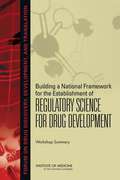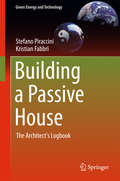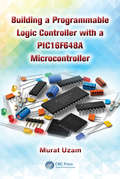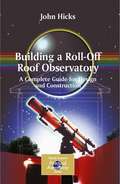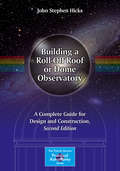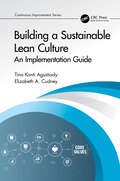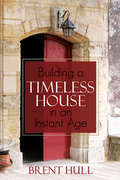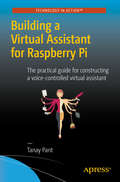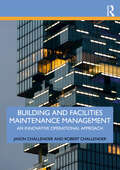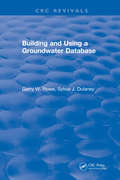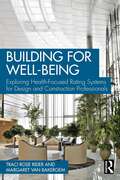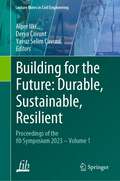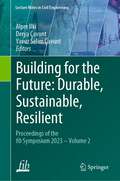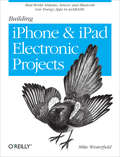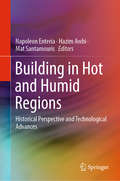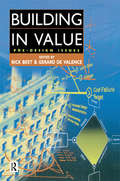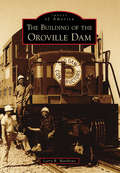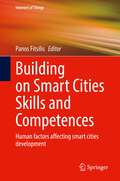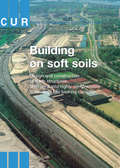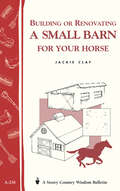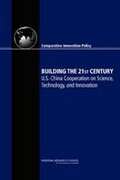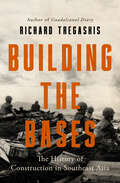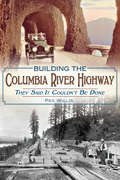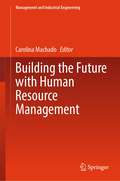- Table View
- List View
Building a Meal: From Molecular Gastronomy to Culinary Constructivism
by Hervé ThisAn internationally renowned chemist, popular television personality, and bestselling author, Hervé This heads the first laboratory devoted to molecular gastronomy-the scientific exploration of cooking and eating. By testing recipes that have guided cooks for centuries, and the various dictums and maxims on which they depend, Hervé This unites the head with the hand in order to defend and transform culinary practice.With this new book, Hervé This's scientific project enters an exciting new phase. Considering the preparation of six bistro favorites-hard-boiled egg with mayonnaise, simple consommé, leg of lamb with green beans, steak with French fries, lemon meringue pie, and chocolate mousse-he isolates the exact chemical properties that tickle our senses and stimulate our appetites. More important, he connects the mind and the stomach, identifying methods of culinary construction that appeal to our memories, intelligence, and creativity. By showing that the creation of a meal is as satisfying as its consumption, Herve This recalibrates the balance between food and our imaginations. The result is a revolutionary perspective that will tempt even the most casual cooks to greater flights of experimentation.
Building a National Framework for the Establishment of Regulatory Science for Drug Development: Workshop Summary
by Institute of Medicine of the National AcademiesThe Food and Drug Administration (FDA) is tasked with ensuring the safety and effectiveness of medicine. FDA's science base must be strong enough to make certain that regulatory decisions are based on the best scientific evidence. The IOM held a public workshop on February 26, 2010, to examine the state of regulatory science and to consider approaches for enhancing it.
Building a Passive House: The Architect's Logbook (Green Energy and Technology)
by Kristian Fabbri Stefano PiracciniThis book describes step-by-step the entire building process of a passive, energy-efficient house in a Mediterranean climate. It chronicles the creation of the Fiorita Passive House in Cesena, Italy, offering designers valuable tips and practical advice for their own projects. Written as a logbook, it not only provides essential technical information but is also an exciting story of the challenges encountered and the solutions that were found. "How and where do I start when building a passive house? Do I need consultants? Will it cost too much? What precautions should I take in a Mediterranean region? What tools do I need? I want to build in wood, but what technical solutions should I use? What must I do regarding plants and equipment? And then, finally, will it really work?" These and many other questions filled the head of the author and designer when he tried his hand at building a passive house in the Mediterranean. The designer, S. Piraccini, had long sought a book that would answer these answers - in vain. So he decided to brave these dangerous waters alone, and after successfully completing his project, he decided to write a book to help others in the same situation. The book is accompanied by detailed information on building physics and HVAC systems by his fellow architect, K. Fabbri.
Building a Programmable Logic Controller with a PIC16F648A Microcontroller
by Murat UzamProgrammable logic controllers (PLCs) are extensively used in industry to perform automation tasks, with manufacturers offering a variety of PLCs that differ in functions, program memories, and the number of inputs/outputs (I/O). Not surprisingly, the design and implementation of these PLCs have long been a secret of manufacturers. Unveiling the mysteries of PLC technology, Building a Programmable Logic Controller with PIC16F648A Microcontroller explains how to design and use a PIC16F648A-microcontroller-based PLC. The author first described a microcontroller-based implementation of a PLC in a series of articles published in Electronics World magazine between 2008 and 2010. This book is based on an improved version of the project, including:Updates to the hardware configuration, with a smaller CPU board and two I/O extension boards that now support 16 inputs and 16 outputs instead of 8An increased clock frequency of 20 MHzImprovements to several macrosFlowcharts to help you understand the macros (functions)In this book, the author provides detailed explanations of hardware and software structures. He also describes PIC Assembly macros for all basic PLC functions, which are illustrated with numerous examples and flowcharts. An accompanying CD contains source files (.ASM) and object files (.HEX) for all of the examples in the book. It also supplies printed circuit board (PCB) (Gerber and .pdf) files so that you can have the CPU board and I/O extension boards produced by a PCB manufacturer or produce your own boards.Making PLCs more easily accessible, this unique book is written for advanced students, practicing engineers, and hobbyists who want to learn how to build their own microcontroller-based PLC. It assumes some previous knowledge of digital logic design, microcontrollers, and PLCs, as well as familiarity with the PIC16F series of microcontrollers and w
Building a Roll-Off Roof Observatory: A Complete Guide for Design and Construction (The Patrick Moore Practical Astronomy Series)
by John Stephen HicksAlmost every amateur astronomer who has taken the pursuit to its second level aspires to a fixed, permanent housing for his telescope, permitting its rapid and comfortable use avoiding hours of setting-up time for each observing session. A roll-off roof observatory is the simplest and by far the most popular observatory design for today's practical astronomers. Building a Roll-off Roof Observatory is unique, covering all aspects of designing a roll-off roof observatory: planning the site, viewing requirements, conforming to by-laws, and orientation of the structure. The chapters outline step-by-step construction of a typical building. The author, both an amateur astronomer and professional landscape architect, is uniquely qualified to write this fully-detailed book. A professionally designed roll-off observatory could cost as much as $3000 just for the plans - which are provided free with Building a Roll-off Roof Observatory.
Building a Roll-Off Roof or Dome Observatory: A Complete Guide for Design and Construction (The Patrick Moore Practical Astronomy Series)
by John Stephen HicksAlmost every practical astronomer eventually aspires to have a fixed, permanent observatory for his or her telescope. A roll-off roof or dome observatory is the answer for the most popular home observatory design. Building a Roll-Off or Dome Observatory will help you decide whether to embark on the venture and will certainly increase your enthusiasm for the project. The author, both an amateur astronomer and a professional landscape architect, answers many of the common questions asked about observatory construction, covering the following topics: * Zoning, and by-law requirements common to most states, towns and municipalities * Where to locate the observatory * How to tailor the observatory for your particular needs * Tools and structural components required * Possible variations in design * How to combine the structure with other structures (incorporating a garden patio under the gantry in the roll-off roof observatory, for example) This fully detailed outlines step-by-step construction, with professional detailed diagrams for each phase of construction.
Building a Sustainable Lean Culture: An Implementation Guide
by Elizabeth A. Cudney Tina AgustiadyThis book is an implementation guide for creating a Lean Culture from the ground up while gaining buy-in from key stakeholders and being able to sustain the results. Everyone talks about implementing a Lean Culture, but only provides Lean Tools for the implementation. This book discusses implementing the entire system from three main aspects. It will cover the people (structural and cultural), the operation system, and the tools. Also included is a full set of case studies to show real-life implementations as well. This text- Discusses Leader Standard work for all employees Covers the escalation process for tiers and daily accountability Shows how to deal with a change of SOP's and standardization within an organization Presents exercises for Lean Tools Implementation Offers real-life case studies of implementing a lean culture while sustaining it Building a Sustainable Lean Culture: An Implementation Guide discusses Lean Leadership from a managerial standpoint and ensures the lean journey does not fail through accountability, standardized work, and technological advances utilizing Lean Systems. Useful in manufacturing, services, IT, and healthcare, this book includes the implementation of empowering employees to want to build a Lean Culture.
Building a Timeless House in an Instant Age
by Brent HullThe author of Traditional American Rooms examines the evolution of home construction, making a case against mass-produced homes.HISTORY®’s Lone Star Restoration star, Brent Hull is a master craftsman, and hands-on preservationist. Hull—a Foreword Reviews Book of the Year Finalist for architectural non-fiction—challenges us to consider the impact our decisions will have when building a house. What do our homes say about us? What stories are they telling? Are they declarations of integrity, beauty, and heritage? Or do they suggest we have lost our sense of value, craft, and harmony?Nationally recognized as an authority on historic design, architecturally correct moldings, and millwork, Hull is uniquely qualified to speak to the craft of building and art of design. In an age of “instant”‘ homes, how do we build something timeless that weaves a tale of character, values, history, and heart? The decisions we make for our homes are not inconsequential. What we build defines us. In fact, the contrast between the way we build today and how structures used to be built has become only more vivid. What happened to craft? What happened to the art of building? Our values and what we believe about life have changed as well. We have come to see houses as a tradable commodity. We live in a time that is obsessed with “what’s next?” We need to be careful of fooling ourselves into thinking that a bottom-line mentality is the best way to approach building a home. Now is the time to examine ourselves, our motives, and our hearts.Praise for Building a Timeless House in an Instant Age“Part call to action, part exploration of technique, the result is a persuasive and enjoyable reminder that our homes are reflections of ourselves . . . . A pleasing, educational look at traditional home construction.” —Kirkus Reviews
Building a Virtual Assistant for Raspberry Pi: The practical guide for constructing a voice-controlled virtual assistant
by Tanay PantBuild a voice-controlled virtual assistant using speech-to-text engines, text-to-speech engines, and conversation modules. This book shows you how to program the virtual assistant to gather data from the internet (weather data, data from Wikipedia, data mining); play music; and take notes. Each chapter covers building a mini project/module to make the virtual assistant better. You'll develop the software on Linux or OS X before transferring it to your Raspberry Pi, ready for deploying in your own home-automation or Internet of Things applications. Building a Virtual Assistant for Raspberry Pi walks you through various STTs and TTSs and the implementation of these components with the help of Python. After that you will start implementing logic for handling user queries and commands, so that the user can have conversations with Melissa. You will then work to improve logic handling to detect what the user wants Melissa to do. You will also work on building some useful applications/modules for Melissa, which will allow you to gain interesting information from Melissa such as the time, weather information, and data from Wikipedia. You will develop a music playing application as well as a note taking application for Melissa, laying the foundations for how Melissa can be further extended. Finally, you will learn how to deploy this software to your Raspberry Pi and how you can further scale Melissa to make her more intelligent, interactive and how you can use her in other projects such as home automation as well. What You'll Learn Design the workflow and discover the concepts of building a voice controlled assistantDevelop modules for having conversations with the assistantEnable the assistant to retrieve information from the internetBuild utilities like a music player and a note taking application for the virtual assistantIntegrate this software with a Raspberry Pi Who This Book Is For This book is for anyone who has built a home automation project with Raspberry Pi and now want to enhance it by making it voice-controlled. The book would also interest students from computer science or related disciplines.
Building and Facilities Maintenance Management: An Innovative Operational Approach
by Jason Challender Robert ChallenderBuilding and Facilities Maintenance Management: An Innovative Operational Approach is a new introductory textbook aimed at students who are studying building maintenance and asset management for the first time as part of their undergraduate or foundation course. The book plugs a gap in the current curriculum and literature which must now seek to educate emerging professionals about the significance of the operational phase of a built asset’s lifecycle, if the challenges of the day are to be met head on.Each chapter is supported by seminar questions and formative assessment tasks to allow the learner to assess their own progress through the text and covers: The nature and importance of building maintenance for the successful strategic operation of an estate contracting and procurement of maintenance works risk assessment in maintenance management surveying for common maintenance issues and defects the relationship between maintenance management and environmental sustainability and maintenance and conservation of historic buildings The book will help readers enhance their awareness, understanding and breadth of knowledge of the issues around improving organisational maintenance management. A handy guide for emerging professionals, this practical book is also ideal reading for anyone studying facilities management, building surveying, construction management, real estate and property management.
Building and Using a Groundwater Database
by Garry RoweBuilding and Using a Groundwater Database is an introductory book that focuses on the fundamentals of groundwater database use. It is an excellent guide for people who collect and use groundwater quality data, hydrogeological data, and general geological data, as well as people who are required to prepare information about groundwater resources for others to use. The book also serves as a textbook for computer-based hydrogeology courses. Many university courses now make use of computerized groundwater data, yet no textbook exists to guide students in database use.Building and Using a Groundwater Database provides detailed information regarding the steps and perspectives required to create a database and use it for groundwater management, land use practices, planning, cleanups, site investigations, and general hydrogeologic reporting. The book is structured to take the reader from the foundations of database development through maintenance and everyday use of the database. Actual examples from selected case studies are used to illustrate database principles. This book is unique in that it deals with the management and structuring of groundwater data, as opposed to the collection and interpretation of data. It illustrates how database software managers can be integrated with groundwater software tools. Building and Using a Groundwater Database provides consultants, engineers, public officials, university instructors, local and municipal water utilities, and banking and loan institutions with a clear, concise guide to using groundwater databases.
Building for Well-Being: Exploring Health-Focused Rating Systems for Design and Construction Professionals
by Traci Rose Rider Margaret van BakergemBuilding for Well-Being is the first introduction to health-focused building standards for design and construction professionals. More than a summary of the state of the field, this practical resource guides designers, builders, developers, and owners through considerations for incorporating WELL®, Fitwel®, and other systems from the planning phase to ground-breaking and beyond. Side-by-side comparisons of established and emerging health-focused standards empower building professionals to select the most appropriate certifications for their projects. Drawing on the authors’ backgrounds in sustainable design and public health, chapters on the evolution of the green building movement and the relationship between health and the built environment provide vital context for understanding health-focused standards and certifications. The final chapter looks toward the future of health and the built environment.
Building for the Future: Proceedings of the fib Symposium 2023 - Volume 1 (Lecture Notes in Civil Engineering #349)
by Alper Ilki Derya Çavunt Yavuz Selim ÇavuntThis book presents the proceedings of the fib Symposium “Building for the future: Durable, Sustainable, Resilient”, held in Istanbul, Turkey, on 5–7 June 2023. The book covers topics such as concrete and innovative materials, structural performance and design, construction methods and management, and outstanding structures. fib (The International Federation for Structural Concrete) is a not-for-profit association whose mission is to develop at an international level the study of scientific and practical matters capable of advancing the technical, economic, aesthetic, and environmental performance of concrete construction.
Building for the Future: Proceedings of the fib Symposium 2023 - Volume 2 (Lecture Notes in Civil Engineering #350)
by Alper Ilki Derya Çavunt Yavuz Selim ÇavuntThis book presents the proceedings of the fib Symposium “Building for the future: Durable, Sustainable, Resilient”, held in Istanbul, Turkey, on 5–7 June 2023. The book covers topics such as concrete and innovative materials, structural performance and design, construction methods and management, and outstanding structures. fib (The International Federation for Structural Concrete) is a not-for-profit association whose mission is to develop at an international level the study of scientific and practical matters capable of advancing the technical, economic, aesthetic, and environmental performance of concrete construction.
Building iPhone and iPad Electronic Projects: Real-World Arduino, Sensor, and Bluetooth Low Energy Apps in techBASIC
by Mike WesterfieldWhy simply play music or go online when you can use your iPhone or iPad for some really fun projects, such as building a metal detector, hacking a radio control truck, or tracking a model rocket in flight? Learn how to build these and other cool things by using iOS device sensors and inexpensive hardware such as Arduino and a Bluetooth Low Energy (LE) Shield.This hands-on book shows you how to write simple applications with techBASIC, an Apple-approved development environment that runs on iOS devices. By using code and example programs built into techBASIC, you’ll learn how to write apps directly on your Apple device and have it interact with other hardware.Build a metal detector with the iOS magnetometerUse the HiJack hardware platform to create a plant moisture sensorPut your iPhone on a small rocket to collect acceleration and rotation dataHack a radio control truck with Arduino and Bluetooth LECreate an arcade game with an iPad controller and two iPhone paddlesControl a candy machine with an iOS device, a micro servo, and a WiFi connection
Building in Hot and Humid Regions: Historical Perspective and Technological Advances
by Napoleon Enteria Hazim Awbi Mat SantamourisThis book presents an in-depth analysis covering climatic and weather conditions, house and building development history, construction methods and technologies, and environmental conditions. It provides relevant house and building information and highlights recent advances in hot and humid regions, as well as developments in other regions that are relevant to hot and humid climates. The countries in hot and humid regions, which include the tropical countries, the Middle Eastern countries around the Mediterranean, and many countries of Central Asia and Africa, are home to some of the most challenging conditions in the world in terms of house and building design and construction, and in terms of maintaining indoor thermal comfort and air quality in an energy-efficient way. The book’s respective chapters, prepared by expert contributors, cover essential concepts, designs, and construction methodologies for houses and commercial buildings. As such, the book offers a valuable resource for undergraduate and graduate students in architecture and engineering, house and building designers, and building sciences researchers. Building contractors, manufacturers and distributors of building equipment and devices, and government policymakers and legislators will also benefit from the information provided in this book.
Building in Value: Pre-Design Issues
by Rick Best Gerard De ValenceThe concept of value in projects is a key issue for everyone involved in the construction industry. Building in Value brings together many experts in the field to outline the wide range of tools, techniques and procedures that can and should be used to make the building procurement phase as efficient as possible. The authors go on to discuss how to ensure that future problems in the design and construction of the buildings are anticipated at the start and to minimise the liklihood of future hiccups. Integrating strategic, financial and construction management techniques, this book provides an essential guide for construction professionals.
Building of the Oroville Dam, The
by Larry R. MatthewsIn the early 1960s, thousands of construction workers and their families came to Oroville, in Northern California, to help build the largest earth-fill dam in the world. Located nine miles northeast of town, the Oroville Dam would be the cornerstone of the California State Water Project, which would provide flood control, electric power, recreation, and water to California residents. The project was so massive that it would reinvent the look of much of the area; require the building of roads, bridges, and railroads; inundate much of the area's history under hundreds of feet of water; and greatly effect the lives of the residents of Oroville. The successful completion of the project came at a price--34 construction workers died.
Building on Smart Cities Skills and Competences: Human factors affecting smart cities development (Internet of Things)
by Panos FitsilisThis book provides insights on skills required to achieve success in smart cities from a variety of industry and human factors perspectives. It emphasizes the balance between learning skills, technical skills, and domain-specific skills in these industries, with special emphasis given to innovative software development models. The authors note that digital transformation requires complementary measures that are not overtly aimed to support infrastructure investment but are instead directed at promoting entrepreneurship, improving digital skills, engaging citizens, applying new transformation strategies, and developing innovative software. All of the above are considered strategically important, especially for medium-sized cities since that enable them to be more competitive in the global economy.
Building on Soft Soils
by CURCentreforCivilEngineeringA comprehensive practical manual covering all aspects of this field, this book covers everything from the pre-design stage up to, and including, the actual use (including maintenance) of the completed structures. Much attention is given to the calculation methods available for design and construction, including establishing the soil parameters required, with emphasis placed on probabilistic safety analysis. This informative book includes an inventory of:· the properties of natural types of soil, secondary materials, and light-weight materials· raising and filling construction methods· techniques and methods to speed up consolidation and limit deformation Compiled by researchers from Fugro, Delft Geotechnics and several other Dutch contractors, it includes useful appendices focusing on particular points of interest from the preceding chapters.
Building or Renovating a Small Barn for Your Horse: Storey Country Wisdom Bulletin A-238 (Country Wisdom Bulletin Ser. #Vol. A-238)
by Jackie ClaySince 1973, Storey's Country Wisdom Bulletins have offered practical, hands-on instructions designed to help readers master dozens of country living skills quickly and easily. <P><P>There are now more than 170 titles in this series, and their remarkable popularity reflects the common desire of country and city dwellers alike to cultivate personal independence in everyday life.
Building the 21st Century: U.S. China Cooperation on Science, Technology, and Innovations
by Charles W. WessnerThe global economy is characterized by increasing locational competition to attract the resources necessary to develop leading-edge technologies as drivers of regional and national growth. One means of facilitating such growth and improving national competitiveness is to improve the operation of the national innovation system. This involves national technology development and innovation programs designed to support research on new technologies, enhance the commercial return on national research, and facilitate the production of globally competitive products. Understanding the policies that other nations are pursuing to become more innovative and to what effect is essential to understanding how the nature and terms of economic competition are shifting. Building the 21st Century U. S. -China Cooperation on Science, Technology, and Innovation studies selected foreign innovation programs and comparing them with major U. S. programs. This analysis of Comparative Innovation Policy includes a review of the goals, concept, structure, operation, funding levels, and evaluation of foreign programs designed to advance the innovation capacity of national economies and enhance their international competitiveness. This analysis focuses on key areas of future growth, such as renewable energy, among others, to generate case-specific recommendations where appropriate.
Building the Bases: The History of Construction in Southeast Asia
by Richard TregaskisA detailed account of the civil engineering work done to assist US forces during the Vietnam War by the New York Times–bestselling author of Vietnam Diary. To fuel their efforts in the Vietnam War, the US armed forces needed reliable infrastructure. For a modern military machine to function properly in a less developed region, a massive construction effort was required. Roads, bridges, ports, airfields, hospitals, and more were needed, and the results helped propel the nation into the modern age. In Building the Bases, veteran war correspondent Richard Tregaskis documents one of the largest wartime construction undertakings in history, a feat accomplished by the US Navy Seabees and other military and American civilian engineers from 1962 to 1972. Using photos, maps, and charts, as well as extensive travel research, Tregaskis looks at every major piece of infrastructure built for the war effort. Through the backdrop of battles and political intrigues, he weaves a compelling human-interest story of courage and hard work.First published in 1975.
Building the Columbia River Highway: They Said It Couldn't Be Done
by Peg WillisThe story behind the construction of the Oregon scenic highway and the men who made it happen.When nine-hundred-foot ice age floods carved the Columbia River Gorge through the Cascade Mountains to the sea, little space was left for man to form a highway of his own. It took an artist-poet-engineer extraordinaire to conquer this reluctant piece of real estate and produce the nation’s first scenic highway. Meet Sam Hill, the mover and shaker, and Samuel Lancaster, the polio survivor, who turned modern engineering on its ear to create a “poem in stone.” Today, Oregon’s historic Columbia River Highway is hidden among the trees, where it meanders past spectacular waterfalls and dramatic views. Ride along with Peg Willis as she explores the beginnings of this miracle highway and the men who created it.
Building the Future with Human Resource Management (Management and Industrial Engineering)
by Carolina MachadoThis book explores the dynamic landscape of contemporary organizations, navigating through topics such as innovation, creativity, emotional intelligence, technology, and sustainability. The book shows how high-skilled workers synergize with machines, emphasizing the evolving nature of work into a talent-centric domain. It delves into human resource management, offering a comprehensive understanding of its strategic significance in fostering innovative, creative, and socially responsible organizations. The chapters guide the reader through an array of topics, from technological trends in HRM to the ethical dimensions of responsible management and the strategic approach to fostering gender equality. Each chapter, authored by experts in management and engineering, serves as a beacon of knowledge, providing executives, managers, engineers, academics, and students with the essential tools and insights needed to propel organizations into the future.

